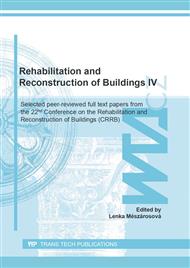p.1
p.9
p.19
p.27
p.35
p.43
p.49
p.57
p.67
Adhesives for the Installation of Cast Basalt Elements on Metal and Comparison of Properties when Using Different Types of Fillers
Abstract:
The polymeric adhesives for the installation of basalt elements on a metal base are designed primarily for environments with increased chemical and mechanical stress. They are composed of polymer resins (epoxy, polyurethane) as binders, as well as organic additives and mineral admixtures that mainly fulfill the function of filler. In all sectors of today's construction industry, maximum efficiency in the production of materials is required for sustainability purposes, which, however, must never be at the expense of the quality or the required performance. Due to these requirements, great emphasis is placed on the maximum use of secondary raw materials. Talc is used as the primary filler for polymer adhesives. Sawdust, tire rubber, and fly ash are used as secondary raw materials. The use of these in building supplies can positively affect some physical and mechanical properties of polymeric adhesives. Also, the use of secondary raw materials has the above-mentioned ecological benefit. Basic properties, such as bulk density and adhesion to both metallic and basalt elements, were monitored. The details of the cohesion of the adhesive with the bonded material, as well as the distribution of secondary raw materials in the polymer matrix, were assessed microscopically.
Info:
Periodical:
Pages:
35-41
Citation:
Online since:
August 2021
Authors:
Keywords:
Price:
Сopyright:
© 2021 Trans Tech Publications Ltd. All Rights Reserved
Share:
Citation:


